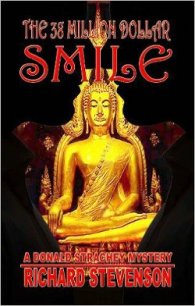Congo - Crichton Michael (книги регистрация онлайн бесплатно .TXT) 📗
Excitement was in the air: as he talked with Ross, Elliot felt something remarkable was about to happen. This expedition with Amy was the first example of an event primate researchers had predicted for years-the Pearl thesis.
Frederick Pearl was a theoretical animal behaviorist. At a meeting of the American Ethnological Society in New York in 1972, he had said, “Now that primates have learned sign language, it is only a matter of time until someone takes an animal into the field to assist the study of wild animals of the same species. We can imagine language-skilled primates acting as interpreters or perhaps even as ambassadors for mankind, in contact with wild creatures.”
Pearl’s thesis attracted considerable attention, and funding from the U.S. Air Force, which had supported linguistic research since the l960s. According to one story, the Air Force had a secret project called CONTOUR, involving possible contact with alien life forms. The official military position was that UFOs were of natural origin-but the military was covering its bets. Should alien contact occur, linguistic fundamentals were obviously critically important. And taking primates into the field was seen as an example of contact with “alien intelligence”; hence the Air Force funding.
Pearl predicted that fieldwork would be undertaken before 1976, but in fact no one had yet done it. The reason was that on closer examination, no one could figure out quite what the advantages were-most language-using primates were as baffled by wild primates as human beings were. Some, like the chimpanzee Arthur, denied any association with their own kind, referring to them as “black things.” (Amy, who had been taken to the zoo to view other gorillas, recognized them but was haughty, calling them “stupid gorillas” once she found that when she signed to them, they did not reply.)
Such observations led another researcher, John Bates, to say in 1977 that “we are producing an educated animal elite which demonstrates the same snobbish aloofness that a Ph.D. shows toward a truck driver… It is highly unlikely that the generation of language-using primates will be skillful ambassadors in the field. They are simply too disdainful.”
But the truth was that no one really knew what would happen when a primate was taken into the field. Because no one had done it: Amy would be the first.
At eleven o’clock, the ERTS cargo plane taxied down the runway at San Francisco International, lifted ponderously into the air, and headed east through the darkness toward
Africa.
DAY 3: TANGIER
1. Ground Truth
PETER ELLIOT HAD KNOWN AMY SINCE INFANCY. He prided himself on his ability to predict her responses, although he had only known her in a laboratory setting. Now, as she was faced with new situations, her behavior surprised him.
Elliot had anticipated Amy would be terrified of the takeoff, and had prepared a syringe with Thoralen tranquilizer. But sedation proved unnecessary. Amy watched Jensen and Levine buckle their seat belts, and she immediately buckled herself in, too; she seemed to regard the procedure as an amusing, if simpleminded, game. And although her eyes widened when she heard the full mar of the engines, the human beings around her did not seem disturbed, and Amy imitated their bored indifference, raising her eyebrows and sighing at the tedium of it all.
Once airborne, however, Amy looked out the window and immediately panicked. She released her seat belt and scurried back and forth across the passenger compartment, moving from window to window, knocking people aside in whimpering terror while she signed, Where ground ground where ground? Outside, the ground was black and indistinct. Where ground? Elliot shot her with Thoralen and then began grooming her, sitting her down and plucking at her hair.
In the wild, primates devoted several hours each day to grooming one another, removing ticks and lice. Grooming behavior was important in ordering the group’s social dominance structure-there was a pattern by which animals groomed each other, and with what frequency. And, like back rubs for people, grooming seemed to have a soothing, calming effect. Within minutes, Amy had relaxed enough to notice that the others were drinking, and she promptly demanded a “green drop drink”-her term for a martini with an olive-and a cigarette. She was allowed this on special occasions such as departmental parties, and Elliot now gave her a drink and a cigarette.
But the excitement proved too much for her: an hour later, she was quietly looking out the window and signing Nice picture to herself when she vomited. She apologized abjectly, Amy sorry Amy mess Amy Amy sorry.
“It’s all right, Amy,” Elliot assured her, stroking the back of her head. Soon afterward, signing Amy sleep now, she twisted the blankets into a nest on the floor and went to sleep, snoring loudly through her broad nostrils. Lying next to her, Elliot thought, how do other gorillas get to sleep with this racket?
Elliot had his own reaction to the journey. When he had first met Karen Ross, he assumed she was an academic like himself. But this enormous airplane filled with computerized equipment, the acronymic complexity of the entire operation suggested that Earth Resources Technology had powerful resources behind it, perhaps even a military association.
Karen Ross laughed. “We’re much too organized to be military.” She then told him the background of the ERTS interest in Virunga. Like the Project Amy staff, Karen Ross had also stumbled upon the legend of the Lost City of Zinj. But she had drawn very different conclusions from the story.
During the last three hundred years, there had been several attempts to reach the lost city. In 1692, John Marley, an English adventurer, led an expedition of two hundred into the Congo; it was never heard from again. In 1744, a Dutch expedition went in; in 1804, another British party led by a Scottish aristocrat, Sir James Taggert, approached Virunga from the north, getting as far as the Rawana bend of the Ubangi River. He sent an advance party farther south, but it never returned.
In 1872, Stanley passed near the Virunga region but did not enter it; in 1899, a German expedition went in, losing more than half its party. A privately financed Italian expedition disappeared entirely in 1911. There had been no more recent searches for the Lost City of Zinj.
“So no one has ever found it,” Elliot said.
Ross shook her head. “I think several expeditions found the city,” she said. “But nobody ever got back out again.”
Such an outcome was not necessarily mysterious. The early days of African exploration were incredibly hazardous. Even carefully managed expeditions lost half of their party or more. Those who did not succumb to malaria, sleeping sickness, and blackwater fever faced rivers teeming with crocodiles and hippos, jungles with leopards and suspicious, cannibalistic natives. And, for all its luxuriant growth, the rain forest provided little edible food; a number of expeditions had starved to death.
“I began,” Ross said to Elliot, “with the idea that the city existed, after all. Assuming it existed, where would I find it?”
The Lost City of Zinj was associated with diamond mines, and diamonds were found with volcanoes. This led Ross to look along the Great Rift Valley-an enormous geological fault thirty miles wide, which sliced vertically up the eastern third of the continent for a distance of fifteen hundred miles. The Rift Valley was so huge that its existence was not recognized until the 1890s, when a geologist named Gregory noticed that the cliff walls thirty miles apart were composed of the same rocks. In modern terms the Great Rift was actually an abortive attempt to form an ocean, for the eastern third of the continent had begun splitting off from the rest of the African land mass two hundred million years ago; for some reason, it had stopped before the break was complete.


![[Magazine 1968-012] - The Million Monsters Affair - Davis Robert Hart (серия книг .txt) 📗](/uploads/posts/books/56864/56864.jpg)

